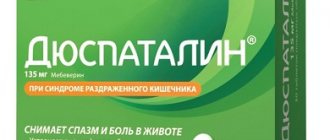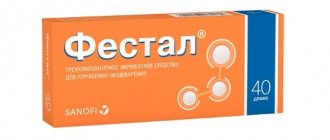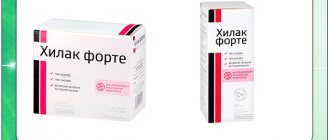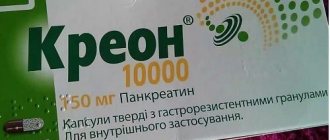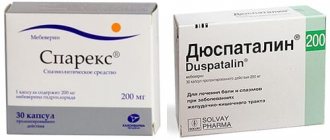Compound
What is the difference between Mezim and Festal? These drugs differ from each other, primarily in their composition.
The active substance of Mezim is pancreatin - an enzyme agent that is obtained from the pancreas of animals.
It contains the following enzymes:
- amylase, necessary for the breakdown of carbohydrates;
- protease, which helps digest proteins;
- lipase, which is necessary for the absorption of lipids.
Mezim is produced in tablets that are coated with a pink enteric coating. The drug has a specific smell of pancreatin, which some people find not very pleasant.
Festal has a more complex composition. One of the active components is also pancreatin. In addition to it, Festal contains 2 other active ingredients:
- hemicellulose, which helps break down fiber, not only improves digestion, but also reduces the amount of gas in the intestines;
- bile, which has choleretic properties, promotes the absorption of lipids, vegetable oils, fat-soluble vitamins, and activates the production of lipase by the pancreas.
Festal is produced in the form of white, round dragees, covered with a coating, which dissolves as soon as the medicine enters the intestines. The drug has a slight vanilla scent.
Festal: advantages and disadvantages
Festal has been popular since Soviet times. Therefore, we can say that it has been actively used for decades.
This drug normalizes the functioning of the intestines and stimulates the absorption of fats.
The main purpose of the medicine is to break down carbohydrates in the small intestine and help the body produce gastric enzymes. In addition, the use of Festal has a beneficial effect on the intestinal microflora.
Festal has a diuretic effect, thanks to which the body is able to effectively cleanse itself of fats. The drug, like Mezim, helps break down fiber, absorb plant foods, and also prevents bloating. Festal has a number of advantages:
- Activates the process of producing enzymes in the digestive tract.
- Speeds up metabolism.
- Positively affects the digestive system as a whole.
- Activates the production of bile.
- The use of the drug “prepares” the human body for an abdominal x-ray.
Another specific feature of the medicine is that its use can prepare the body for the use of a prosthetic (artificial) jaw.
However, not everything is so perfect. Festal, like Mezim, like Pancreatin, has certain contraindications for its use.
Therefore, consultation with a doctor before using the medicine is mandatory. This way you can avoid a number of side effects, the consequences of which can be disastrous.
The disadvantages of the drug are:
- Pregnant and breastfeeding women (sometimes the use of Festal is possible, but only under the supervision of a doctor and with strict adherence to the dosage).
- Presence of cholelithiasis.
- Predisposition to intestinal disorders.
As for side effects, after studying the instructions for the drug, you can find the following:
- Inflammation of the mucous membranes of the mouth and nasopharynx
- Allergy to the components of the medication.
Indications and contraindications
Application area
Festal and Mezim have common indications for use. They are prescribed in the following cases:
- healthy people with digestive disorders caused by overeating, the inability to chew food thoroughly, for example, due to wearing braces, prolonged immobilization, physical inactivity;
- before an ultrasound or x-ray of the abdominal cavity;
- for chronic pancreatitis, cystic fibrosis, since in these diseases the pancreas produces an insufficient amount of enzymes;
- simultaneously with other drugs, Festal and Mezim are prescribed for chronic inflammatory-dystrophic diseases of the gastrointestinal tract, during removal or irradiation of the stomach, gallbladder, liver or intestines, for all those conditions where digestive disorders, loose stools, and increased gas formation are observed.
What then is the difference between Festal and Mezim? These drugs differ in their contraindications for use.
Contraindications
Both of these medications are contraindicated if the patient has:
- hypersensitivity to the composition of the drug;
- acute pancreatitis or chronic inflammation of the pancreas beyond the stage of remission.
Important! Some patients suffering from cystic fibrosis, when taking Festal and Mezim in large dosages, may develop stenosis of the valve of the Tower.
In addition, Festal is contraindicated in patients suffering from the following pathologies:
- stones and accumulations of pus in the gallbladder;
- extrahepatic cholestasis;
- intestinal obstruction;
- liver failure, which can lead to hepatic precoma or encephalopathy;
- liver inflammation;
- increasing the concentration of bilirubin in the blood;
- tendency to upset stomach.
Festal is not prescribed to patients under 3 years of age. This is due to the fact that a small child cannot swallow the pills whole. After all, if the enteric coating is broken, the enzymes will be destroyed under the influence of hydrochloric acid in the gastric juice and there will be no effect from taking Festal.
Mezim can also be prescribed to children only if they can swallow the tablet whole.
Important! Festal and Mezim can be prescribed to pregnant women and breastfeeding women with caution, since there is not enough data on the safety of using enzyme preparations in these categories of citizens.
Indications of drugs
The drugs have almost identical indications. This is explained by the presence of pancreatin in their composition and the manifestation of similar pharmacological actions.
Mezim is prescribed for:
- dyspepsia;
- eating unusual, fatty and indigestible foods;
- chronic pancreatitis;
- flatulence associated with impaired digestion of food;
- hyposecretion of the pancreas.
Indications for use of Festal:
- chronic pancreatitis;
- indigestion due to colitis, irritable bowel syndrome, insufficient secretion of enzymes by the pancreas;
- eating indigestible, unusual, fatty foods;
- violation of chewing function;
- improving the absorption of fat-soluble vitamins.
Undesirable effects and cases of overdose
While taking Mezim and Festal, the same adverse reactions may occur:
- allergies, which can manifest as watery eyes, sneezing and redness of the skin;
- dyspeptic disorders such as nausea, constipation or loose stools, but these same symptoms are observed with a deficiency of enzymes that are characteristic of chronic pancreatitis;
- epigastric pain;
If recommended doses are exceeded, hyperuricemia and hyperuricosuria may occur. In this case, you need to interrupt treatment. There is no antidote; drugs are prescribed that eliminate the symptoms of overdose.
Admission rules
It is recommended to take Mezim and Festal during meals and immediately after it. Dragees and tablets should be swallowed whole with water. The duration of therapy and dosage are determined by the doctor individually. It can vary from several days (if there is an error in the diet or before an ultrasound and x-ray of the abdominal cavity) to several months and years (with replacement therapy).
Important! Mezim is very often counterfeited. To find out whether the drug is real or not: there is a hologram in the upper left corner; if you erase it, you can find the letter M.
Festal and Mezim should not be taken simultaneously with antacids whose active substances are magnesium hydroxide or calcium carbonate, since in this case the effectiveness of enzyme preparations may decrease.
While taking Mezim and Festal, the absorption of medications containing iron may decrease.
In addition, when taking Festal cimetidine simultaneously, the effect of enzymes is enhanced.
When taking Festal in parallel with antibiotics, sulfonamides and PAS, the adsorption of the latter increases.
Important! In order for the effect of taking enzyme preparations to be effective, they must be stored correctly. Festal should be stored at a temperature no higher than 25 degrees, Mezim - 30 degrees, in a place where children cannot reach them. The shelf life of both medications is 36 months, after which the medications cannot be taken, as they can be harmful to health.
Despite the fact that both medications are available without a doctor’s prescription, you cannot take them on your own, as they have their own contraindications for use. In addition, with frequent use of enzyme preparations, the pancreas will stop producing enzymes itself, so it is better to follow a diet, avoid fatty, fried foods, and alcoholic beverages.
Precautionary measures
All enzyme preparations, including Mezim and Festal, cannot be taken simultaneously with:
- drugs intended to treat anemia, as they interfere with the absorption of iron by the body;
- medications that reduce the level of acidity in the stomach. In this case, the effectiveness of the former decreases.
During pregnancy and lactation, Festal and Mezim can be taken only in cases where the expected benefit to the mother outweighs the potential harm to the fetus.
Author : Skryagina Ekaterina, especially for the site Zhkt.ru
Analogues of Festal and Mezim
A complete analogue of Mezim is Pancreatin, which has the same indications, prescription restrictions, and undesirable effects.
What is the difference between Festal and Pancreatin. First of all, they differ in their composition. Pancreatin is a partial analogue of Festal; they have the same indications for use and adverse reactions. But the contraindications for use of these drugs differ. What is better Festal or Pancreatin? The bile contained in Festal can provoke the movement of stones in gallstone disease. This can cause blockage of the bile ducts. Complete obstruction will provoke an enlargement of the liver and stretching of its capsule. All this is accompanied by constant dull pain and a feeling of heaviness in the right side. Obstructive jaundice develops, in which there is discoloration of stool, yellowing of the skin and sclera of the eyes. There may also be a rise in temperature, excessive sweating and cramps.
Therefore, in case of cholelithiasis, preference should be given to Mezim or Pancreatin.
Another complete analogue of Mezim and Pancreatin is Creon. Its active substance is also pancreatin, but the drug is produced in gelatin capsules, each of which contains mini-microspheres coated with an enteric coating. Creon is convenient to use for the treatment of small children who cannot swallow Festal tablets or Mezim and Pancreatin tablets without chewing or crushing them. And if the integrity of the dosage form is compromised, then its contents will be destroyed by the action of gastric juice and there will be no effect from taking enzymes. Therefore, in children it is advisable to use Creon rather than Festal, Mezim or Pancreatin; for this, the gelatin capsule must be opened and its contents mixed with water or food and given to the child.
Instead of Creon, children can be given Micrasim. It also contains pancreatin and is available in gelatin capsules containing pellets - solid particles coated with an enteric coating, the size of which varies from 2000 to 5000 microns. But Mikrasim costs less than Creon.
It is difficult to say unequivocally that Festal, Mezim or Pancreatin is better. The doctor must decide; only a specialist can select the right drug, taking into account existing contraindications for use. In addition, only a doctor can choose the correct dosage and duration of therapy.
Festal and Mezim are popular enzyme medicines. They are taken both to treat gastrointestinal diseases and to eliminate symptoms of overeating. The active component in both drugs is pancreatin, obtained from the pig pancreas.
Festal and Mezim are enzyme medicines. They are taken to treat gastrointestinal diseases and eliminate symptoms of overeating.
The most popular analogues: description
Creon is a substitute for Mezim. It is usually prescribed if a person has problems with the gastrointestinal tract. In addition, to restore the functioning of the stomach, you can use medications such as Ermital, Abomin, etc. Let’s take a closer look at the most popular ones, and you can also decide which drug is better to use – Festal or Mezim.
Pancreatin
It can replace Mezim; the medicine is produced by Russian pharmaceutical factories. It is noteworthy that the price of tablets can vary significantly - it all depends on what kind of substrate was used and where it was produced. The same applies to excipients - they may vary.
Basically, Pancreatin is produced with a pink shell, but in some cases a white one is also found. It is these tablets that are used if it is necessary to give therapy to a patient who is in a supine position; they almost always have problems with intestinal motility - due to the fact that the person cannot chew food on his own. If you have a choice - Mezim or Pancreatin, then it is important to take into account the doctor’s recommendations.
The drug has side effects - diarrhea and vomiting may occur. Experts say that this is what distinguishes Mezim from Pancreatin. The dosage of the latter should be accurately calculated, since in case of individual intolerance to the active ingredients of the drug, the patient experiences swelling and a rash on the skin.
You should not look for cheaper analogues of Mezim - cheap drugs almost always use low-quality ingredients, they provoke the appearance of allergic reactions.
Creon
This analogue of Mezim has a fairly high cost; it is produced in the form of capsules. After the capsule enters the small intestine, the shell dissolves, the granules are released and begin to actively break down carbohydrates, fats, and proteins.
This drug is praised for the fact that it helps the stomach not only digest food, but is also a powerful adsorbent. This medicine is prescribed to patients suffering from severe flatulence and those who need to restore the gastrointestinal tract after antibiotic therapy.
Hermital
This is a substitute for Mezima forte, used to compensate for the lack of enzymes in the body necessary for normal stomach function.
These enteric capsules contain the following ingredients:
- Trypsin;
- amylase;
- chymotrypsin;
- lipase;
- protease.
All of the above compounds are involved in the process of digesting food, and they also perfectly relieve pain in the epigastric area. Already 25-30 minutes after using the drug, a pronounced effect is noted.
To achieve maximum results, the medicine is washed down with clean water without gases, judging by the reviews of patients who were treated with this drug. This pharmacological drug is prescribed to patients with digestive problems.
Motilium
Available in tablets, the purpose of the medication is to alleviate the condition of patients with the following pathologies:
- Dyspepsia, as a rule, such conditions are associated with gastroesophageal reflux, accompanied by delayed bowel movement;
- It is also important to take a Mezim substitute if the patient feels severe discomfort in the stomach after eating, the presence of bloating, or if belching or vomiting occurs;
- gastroenterologists prescribe the drug in the presence of vomiting, which is functional or infectious in nature (when undergoing radiation therapy, or in the case of stomach diseases due to dietary disorders);
- regurgitation syndrome, repeated vomiting, reflux and other problems with gastric motility - can be taken by both children and adults.
What is the difference between this drug and Mezim? It is safe to say that it is softer, its action is aimed not only at helping the stomach after episodes of overeating, but also relieves associated problems - nausea, flatulence.
This drug is based on an active ingredient called Domperidone. This ingredient allows you to stimulate the function of the stomach, helping it get rid of food debris. Motilium therapy is also carried out if the patient has a pronounced gag reflex.
Characteristics of Festal
Festal is produced in the form of enteric tablets. Pancreatin is an active substance that contains digestive enzymes:
- amylase – participates in the digestion of carbohydrates;
- lipase – breaks down fats;
- protease – breaks down proteins.
The composition also contains bile components and hemicellulose. Bile acids help digest food. The enzyme hemicellulose takes part in the digestion of plant fiber.
After consuming Festal, the active ingredient is released in the small intestine, where it has a therapeutic effect.
The medicine is indicated for the following conditions:
- disorder of the exocrine function of the pancreas;
- flatulence, non-infectious diarrhea;
- irritable bowel syndrome;
- diffuse liver diseases;
- chronic gastritis, colitis, cholecystitis, duodenitis.
Festal is taken for disorders of the exocrine function of the pancreas.
In patients without gastrointestinal pathologies, it is used to improve digestion.
The drug is indicated for diseases of the esophagus, as well as in preparation for ultrasound and x-ray examination of the abdominal organs.
Contraindications to the use of Festal:
- increased sensitivity;
- hepatitis;
- acute pancreatitis;
- exacerbation of chronic pancreatitis;
- liver failure;
- hepatic coma or precoma;
- jaundice;
- acute purulent inflammation of the gallbladder;
- hyperbilirubinemia;
- intestinal obstruction;
- predisposition to diarrhea;
- cholelithiasis;
- age up to 3 years.
Pregnant and lactating women are prescribed with caution.
Festal is prescribed to pregnant women with caution.
- allergic reactions (itching, skin rash, lacrimation, runny nose);
- disruptions in the digestive system (abdominal pain, nausea, diarrhea);
- hyperuricemia, hyperuricosuria, irritation of the oral mucosa and anus (occur when taking an increased dosage).
Festal: advantages and disadvantages
Festal has been popular since Soviet times. Therefore, we can say that it has been actively used for decades.
This drug normalizes the functioning of the intestines and stimulates the absorption of fats.
The main purpose of the medicine is to break down carbohydrates in the small intestine and help the body produce gastric enzymes. In addition, the use of Festal has a beneficial effect on the intestinal microflora.
Festal has a diuretic effect, thanks to which the body is able to effectively cleanse itself of fats. The drug, like Mezim, helps break down fiber, absorb plant foods, and also prevents bloating. Festal has a number of advantages:
- Activates the process of producing enzymes in the digestive tract.
- Speeds up metabolism.
- Positively affects the digestive system as a whole.
- Activates the production of bile.
- The use of the drug “prepares” the human body for an abdominal x-ray.
Another specific feature of the medicine is that its use can prepare the body for the use of a prosthetic (artificial) jaw.
However, not everything is so perfect. Festal, like Mezim, like Pancreatin, has certain contraindications for its use. Therefore, consultation with a doctor before using the medicine is mandatory. This way you can avoid a number of side effects, the consequences of which can be disastrous.
The disadvantages of the drug are:
- Pregnant and breastfeeding women (sometimes the use of Festal is possible, but only under the supervision of a doctor and with strict adherence to the dosage).
- Presence of cholelithiasis.
- Predisposition to intestinal disorders.
As for side effects, after studying the instructions for the drug, you can find the following:
- Inflammation of the mucous membranes of the mouth and nasopharynx
- Allergy to the components of the medication.
Characteristics of Mezim
The composition of the drug Mezim includes pancreatin. Pancreatin enzymes help digest proteins, fats and carbohydrates, which play an important role in many body processes.
The action of the medication is aimed at producing the internal organs’ own enzymes. Bile begins to be actively produced, restoring the digestive process. This allows you to digest and assimilate even the fattiest, heaviest foods.
Mezim is produced in the form of tablets coated with a soluble coating. It protects the active substance from the effects of gastric juice. Without such a shell, the therapeutic effect would be reduced.
The drug is indicated in the following cases:
- pancreatic diseases;
- chronic pancreatitis;
- flatulence, bloating, diarrhea;
- cystic fibrosis;
- pathologies of the gastrointestinal tract and liver;
- enzyme deficiency after surgery on the intestines or stomach;
- preparation for diagnostic examinations.
The drug should not be used in acute pancreatitis, exacerbation of chronic pancreatitis, or hypersensitivity. Can be taken by pregnant and lactating women. But it is worth considering that adequate research has not been conducted in these areas.
Differences between drugs
Festal and Mezim can be bought at any pharmacy without presenting a prescription from a doctor. But before you purchase one of the products, you need to find out how they differ.
The first difference is the composition of Mezim and Festal:
- Festal contains 3 active ingredients: pancreatin, hemicellulose and bovine bile. The lipolytic activity of pancreatin in the drug is 6000 OD. E.F., amylolytic – 4500 OD. E.F., proteolytic – 300 OD. E.F. Each dragee contains 0.005 g of hemicellulose, and 0.025 g of bovine bile powder.
- Mezim Forte, unlike Festal, contains only one active substance - pancreatin, extracted from the pork pancreas. Each tablet of the drug contains from 93 to 107 g of pancreatin, which exhibits lipolytic activity - 3500 OD. E.F., amylolytic – 4200 OD. E.F. and proteolytic – 250 OD. E.F.
Pancreatin improves and accelerates digestive processes and the absorption of proteins, fats and carbohydrates in the intestines. Hemicellulose affects the breakdown of plant fiber and normalizes intestinal microflora. Bile emulsifies fats and increases lipase activity.
There are also differences in the composition of the excipients, but this practically does not matter. The exception is individual intolerance to one or more of them.
The second difference between drugs is the manufacturer. It would seem that this is not a very important characteristic of the drug, but often the quality of the drug depends on it.
- Festal is manufactured by Sanofi India Limited.
- Mezim is produced by the famous German company Berlin-Chemie.
Compound similarities
These drugs contain the same active ingredient – pancreatin. But the amount of enzymes is slightly different. So, 1 tablet of Mezim contains:
- 3500 units of lipase;
- 4200 amylase units;
- 250 units of protease.
The composition contains auxiliary components:
- microcrystalline cellulose;
- sodium salt of carboxymethyl starch;
- colloidal silicon dioxide;
- Magnesium stearate.
- 6000 units of lipase;
- 4500 units of amylase;
- 300 units of protease.
Also contains:
- 50 mg hemicellulose;
- 25 mg ox bile extract.
One of the auxiliary components of Festal is castor oil.
Festal has different auxiliary components:
- Castor oil;
- sucrose;
- gelatin;
- dextrose;
- cellacephate;
- ethyl vanillin;
- acacia gum;
- titanium dioxide;
- macrogol;
- glycerol
Thus, the composition of the drugs is the same. The only difference is in the enzyme activity of enzymes and excipients. When prescribing Festal or Mezim, the doctor takes these features into account.
The composition of the drugs is the same. The only difference is in the enzyme activity of the enzymes.
Compositions of drugs
Medicines have different manufacturers, but do not differ significantly in composition.
Festal
Manufactured and produced in India. They look like white dragees, have a core and a shell around it, and smell like vanilla. It contains active Pancreatin, but with an increased dosage. In addition to it, the complex composition contains hemicellulase and bovine bile extract. The first is responsible for the breakdown of fiber, additionally removing gases. Secondly, it has choleretic properties and helps the absorption of substances. They are what differentiate the two drugs from each other. The complex of these two elements breaks down fats, carbohydrates and proteins more effectively. Promote the absorption of vitamins contained in the tablets.
Festal also contains castor oil, gelatin, dextrose, ethyl vanillin, sucrose, cellacephate, acacia gum, glycerol, macrogol, titanium dioxide in small dosages. They are not dangerous only if the patient does not have an individual allergy to them.
Mezim
Made in Germany by Berlin-Chemie. These are pink, round-shaped tablets with a certain odor. They consist of a core and a shell. Incoming elements:
- Lipase – responsible for fats;
- Amylase – responsible for proteins;
- Protease – responsible for carbohydrates.
All the substances together give Pancreatin, Mezim also contains: microcrystalline cellulose, colloidal silicon dioxide, carboxylmethyl starch sodium salt and magnesium stearate.
What is the difference between Festal and Mezim
The drugs have a number of minor differences:
- Mezim contains fewer enzymes, so it is considered safer. The drug has a pronounced odor. The list of contraindications is short, because... contains no bile.
- Festal has a pleasant taste, but it should not be used for a number of diseases. Large list of contraindications.
Medicines are produced by different manufacturers. Festal is produced by an Indian pharmaceutical company, Mezim by a German company. It is also important that Mezim is cheaper than Festal. Although prices at different pharmacies may vary.
What is better to use Festal or Mezim
Both drugs have been used in gastroenterology for a long time and have proven themselves, which makes it difficult to choose. But based on numerous reviews from doctors and patients, we can conclude:
- Mezim is well suited for long-term treatment of pancreatic diseases and restoration of digestion.
- Festal should not be used for diseases of the liver and gall bladder. It is better to take this medicine for a short time.
- Both drugs are great for treating symptoms of overeating. But one cannot call one drug a substitute for another.
Mezim and Festal are medications, so only a doctor should prescribe them.
Mezim and Festal are medications, so only a doctor should prescribe them. When choosing, the severity of the disease and the individual characteristics of the body are taken into account.
What is the difference between Mezim and Festal?
Mezim is a well-known German enzyme preparation, presented in three forms: Forte, 10000, 20000 (20 or 80 pieces per package). The difference between them is only quantitative and is determined by how many enzymes are in one tablet. Thousands are international units that measure the effectiveness of lipase, the main enzyme responsible for the breakdown of fats. The higher this indicator, the “stronger” the drug.
In addition to lipase, Mezim contains protease (protein breakdown) and amylase (carbohydrate breakdown). Their activity is also measured in units, but since pancreatic secretory insufficiency is primarily manifested by lipase deficiency, the gradation of pancreatin preparations according to their potency is indicated by lipase units.
Mezim Forte – 20 tablets
The French Festal also contains these enzymes, there are more of them than in Mezim Forte, but less than in Mezim 10 and 20 thousand (see comparative table below). Available in 20, 40 or 100 tablets. The main difference between Festal and Mezim is the presence of bile and hemicellulase components in each tablet. This addition ensures a more comprehensive participation of the drug in the digestion of food.
- Components of bile
:- enhance lipase activity in the breakdown of fats,
- moderately enhance the contractility of the gallbladder during dyskinesias,
- Helps absorb fat-soluble vitamins
- have a slight laxative effect due to increased intestinal motility.
- Hemicellulase
is an enzyme responsible for the breakdown of plant fiber in the intestines. In a healthy person, this substance is produced in sufficient quantities by the natural microflora. When there is a disturbance in the normal flora or a deficiency of this enzyme, fermentation processes begin, manifested in excess gas formation and flatulence. The amount of hemicellulase in one Festal tablet is not so large as to ensure complete replacement of its deficiency in case of intestinal problems; one can only count on an auxiliary effect.
What to choose?
Both drugs have been used in gastroenterology for a long time and have proven themselves well. When choosing between Festal or Mezim, it is better to proceed from the diagnosis made by the doctor. Mezim 10,000 or 20,000 is best used for long-term systematic treatment, for example, for chronic pancreatitis, selecting the desired dosage of tablets. Mezim Forte or Festal is taken individually or short-term to help digestion. Festal is also advisable in the presence of JPV (hypokinetic type), during diets that require an increased amount of plant fiber in the diet (greens, bran, vegetables), and for constipation associated with poor nutrition.
Reviews from doctors
Dmitry Levin (gastroenterologist), 47 years old, Moscow
I often prescribe Mezim to my patients, I think that it is more effective. With the correct dosage, the risk of side effects is minimized. Festal is a more “heavy” drug and requires monitoring of the dosage regimen. Often patients begin to self-treat with it and go to the doctor with symptoms of overdose.
Marina Vladimirova (gastroenterologist), 37 years old, Murmansk
Mezim is produced by a German pharmaceutical company, which indicates high quality. I only prescribe it to my patients. The therapeutic effect occurs quickly, which is important for gastrointestinal diseases.
What is better to choose between Festal and Pancreatin? What are the benefits of each drug and what is the difference between them? Read here.
Patient reviews of Festal and Mezim
Igor, 50 years old, Voronezh
I take Festal after a heavy meal or during meals. It helps quickly, 1 tablet is enough to feel light again. Festal is always present in my first aid kit.
Victoria, 33 years old, Bryansk
The doctor said that I had IBS (irritable bowel syndrome) and recommended that I follow a diet. But it happens that I eat junk food, and all the signs of illness immediately appear. Diarrhea is especially troubling. But after a course of treatment with Mezim, this unpleasant symptom disappeared.
Ekaterina, 44 years old, Sevastopol
I was poisoned by low-quality products. Abdominal pain, bloating, heartburn and nausea immediately appeared. The condition was terrible. Festal was home. After the first dose I felt an improvement, and after 2 days everything went away. I didn’t even know that this drug could also cope with poisoning.
The pharmaceutical market is filled with many pharmaceutical drugs designed to compensate for impaired functions of the gastrointestinal tract. Choosing an enzymatic agent that can alleviate symptoms caused by pancreatic pathology is an extremely difficult task. Very often the question arises about prescribing one of two medications - Festal or Mezim, which only a doctor can best advise!
Briefly, the pancreas and its functional insufficiency
The pancreatic gland is an organ that performs exocrine and endocrine functions. The gland secretes a number of important enzymes necessary for adequate absorption of incoming food (amylase - for the digestion of carbohydrates, lipase - for the purpose of breaking down animal and vegetable fats, protease - for the breakdown of proteins into amino acids and their passage through the intestinal mucous barrier).
Exposure to any negative factors (alcohol abuse, poor diet, sedentary lifestyle, lack of constant physical activity, autoimmune diseases, infectious and inflammatory pathologies) can lead to disruption of the synthesis of one or all groups of enzymes and, as a result, to digestive problems.
Characteristics of drugs
Both drugs are intended to compensate for the lack of enzymes, correct the functions of the gastrointestinal tract and regulate the activity of the pancreatic gland. Mezim and Festal restore appetite and reduce the severity of dyspeptic disorders.
The components included in the production of medicines are obtained from the pancreas of cattle (cows, bulls, goats, sheep) and contain pancreatin - a substance consisting of protease, lipase and amylase.
The drugs are enteric-coated and their effect begins only from the moment they enter the intestine, where they are normally excreted through the major duodenal papilla.
Why are enzyme preparations needed?
Our body has special substances - enzymes that break down, help absorb and remove food. If the digestive system malfunctions, a lack of these substances may occur, and then problems and unpleasant phenomena with the gastrointestinal tract begin.
The most effective means for the production of enzymes is pancreatin, the main component of Festal and Mezim. This is an absolutely safe component containing lipase, amylase and propase. Without these enzymes, the functioning of the digestive system is impossible.
Indications for use
Both medications are indicated for the correction of gastrointestinal problems caused by enzymatic insufficiency of the pancreas.
However, Festal has a higher range of indications, since it contains components of animal bile and is additionally used to compensate for impaired functions of the liver or biliary tract.
|
| Festal |
|
| Mezim |
Mezim
The action of Mezim is similar to the action of Festal, with the exception of the properties that bile in its composition gives Festal. Mezim contains a smaller amount of enzymes (in action units). Therefore, we can talk about the safety of this drug to a greater extent than Festal. For the same reason, Mezim is prescribed, if necessary, in pediatric and obstetric practice (for children and pregnant women). Mezim enzymes promote the breakdown of food into components (proteins, fats, carbohydrates) with their further digestion and absorption.
The disadvantages of Mezim include the specific smell emanating from the tablets. Sometimes taking the drug can cause nausea and even vomiting. Indications and contraindications are also similar to those that apply to Festal. The advantage of Mezim is manifested in its possible use for cholelithiasis due to the lack of a choleretic effect.
Contraindications for use
Restrictions on use differ for both drugs, and their volume is determined by the components of the composition.
|
| Festal |
|
| Mezim |
Side effects of drugs
|
| Festal |
|
| Mezim |
conclusions
Thus, comparing these drugs, we can come to the following conclusions:
- Mezim, unlike Festal, can be used over a long course.
- Festal is contraindicated in case of cholelithiasis (as it contains natural bile) and liver damage.
- These drugs should be prescribed only by a doctor, after determining the cause of the disease.
- Uncontrolled use of medications can lead to irreversible consequences in any organ of the abdominal cavity.
|
| Festal |
|
